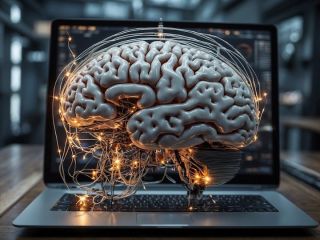Artificial Intelligence
The Great Digital Demise
Digital transformation is giving way to the cognitive revolution.
Posted November 10, 2023 Reviewed by Davia Sills
Key points
- We're entering the Cognitive Age, where human thought is integral to innovation.
- AI and language models are now working hand-in-hand (and mind-in-mind) with humans.
- Humans and machines are teaming up for creative solutions.
- Tech is extending people's brainpower, redefining what they can achieve.

News flash: The Digital Age is over.
As we transition from the era of digital domination, where technology led the march of progress, we are entering a fundamentally different epoch. This new era—the Cognitive Age—pivots on a central, transformative theme: The essence of being human—our thoughts, our consciousness, our very cognitive processes—are becoming the forefront of innovation and technological advancement.
This shift signals a move beyond the conventional ideas where technology and digitalization were the harbingers of change. In the digital era, we marveled at the prowess of binary code and silicon chips, which transformed our physical world in unprecedented ways. The narrative was primarily about machines and systems, about algorithms and automations. The value of these advances is still critical and fundamental to our path forward. However, as groundbreaking as these developments were, they set the stage for an even more revolutionary shift.
Enter the Cognitive Age, where the focus transcends technological tools and zeros in on the human mind itself, in partnership with the very technologies that were once the main act. This age is not defined merely by the tools we create but by how these tools intertwine with, extend, and enhance our cognitive capacities.
At the core of this transformation are technologies like generative pre-trained transformers and advanced large language models (LLMs). While these tools are technological marvels, what sets them apart is their ability to interact with, and augment human thought processes. Unlike the earlier eras of technological advancement, where human interaction with technology was largely unidirectional, we are now looking at a future where the interaction is reciprocal.
In this emerging Cognitive Age, technology no longer stands apart from humanity; it becomes an extension of us. The boundary between user and tool is blurring as these cognitive technologies learn from and adapt to us, offering not just solutions or enhancements but genuine partnerships in thought and creativity.
This shift brings with it a renewed emphasis on the uniquely human aspects of creativity, emotion, and ethical decision-making. As AI and LLMs grow more sophisticated, they don't just process data; they start to understand context, emotion, and subtlety in a way that resembles human thought. This capability does not replace human cognition but complements it, leading to a co-evolution of human and machine intelligence.
In fact, this unique synergy is coming to life with the recent launch of the Humane AI Pin. This $699 device, comprising a square unit and a magnetic battery pack, simplifies interaction with technology. Controlled via voice, camera, gestures, and a small projector, it weighs just 54 grams in total. Notably, it doesn't continuously record or listen passively, ensuring privacy and user control.
At the heart of the AI Pin is its connection to AI models, especially ChatGPT, facilitated by the Cosmos operating system. This system bypasses traditional app usage, routing user queries directly to relevant tools. The AI Pin's functionality extends beyond mere gadgetry; it's a wearable, AI-powered assistant capable of voice messaging, summarizing emails, analyzing food for nutritional information, and providing real-time translations. Future updates promise navigation and shopping features, with an open invitation for developers to further expand its capabilities.
This co-evolution has significant implications for innovation. The Cognitive Age pushes us to reimagine the nature of problem-solving, creativity, and ideation. It challenges us to rethink the dynamics of how we interact with technology, shifting from a mindset of creating tools to facilitate human tasks to fostering an environment where human and machine intelligence co-create, co-innovate, and collectively transcend the limitations of each.
Moreover, this shift underscores a fundamental truth: In the Cognitive Age, humanity isn't just the beneficiary of innovation but an integral component of it. The technology doesn't just serve us; it engages with us, learns from us, and in turn, we adapt and learn from it. This symbiosis is reshaping not just our tools and processes but our very conception of what it means to be human in a technologically advanced world.
It's in this confluence of human and artificial cognition that the true transformative power of the Cognitive Age lies. It's an era where our tools don't just do more for us; they think with us, and in doing so, they elevate our capacity for thought, creativity, and innovation. As these cognitive technologies become more ingrained in our daily lives, they not only change the way we work and play but also the way we perceive the world and ourselves within it.
The Cognitive Age heralds a celebration of humanity, not through the lens of what technology can do for us but through the fascinating perspective of what we can achieve together with technology. This isn't just a technological revolution; it's a human one. As we stand on the threshold of this new age, we recognize that the most extraordinary aspect of this era is not the technology itself, but the unprecedented partnership between human and machine intelligence, a partnership that promises to redefine our future in ways we are only beginning to imagine.




